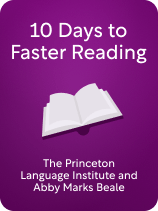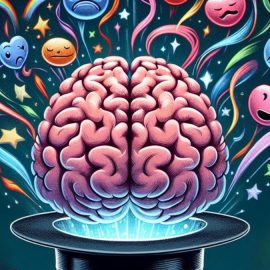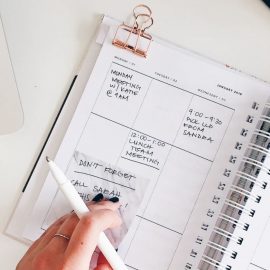

This article is an excerpt from the Shortform book guide to "10 Days to Faster Reading" by The Princeton Language Institute and Abby Marks Beale. Shortform has the world's best summaries and analyses of books you should be reading.
Like this article? Sign up for a free trial here.
Do you have a pile of reading material you’ve been meaning to read for ages? Do you feel you could learn more if only you could read faster?
In 10 Days to Faster Reading, Abby Marks Beale and the Princeton Language Institute provide strategies to help you zip through web pages, books, magazines, and newspapers. Not only can you read faster, but you can understand and remember everything you read.
Here’s our overview of this practical book that can propel you toward a personal reading revolution.
Overview of 10 Days to Faster Reading
In 10 Days to Faster Reading, Abby Marks Beale and the Princeton Language Institute offer a variety of strategies to help you reach your reading goals. By practicing their speed-reading techniques, you can learn new information more efficiently, rid yourself of unhelpful reading habits, and understand the things you read on a deeper level. (Their techniques particularly apply to reading non-fiction books.)
(Shortform note: Speed-reading is a technique that focuses on quickly discerning and comprehending whole phrases and sentences at once. It contrasts with the methods students are typically taught when they’re first learning how to read, in which they read texts word for word. Speed-reading techniques first became popular in the United States in the 1950s and maintain their popularity today.)
Abby Marks Beale has been teaching students and professionals her speed-reading techniques for 35 years. Now, she mostly visits corporations and conferences to present her speed-reading course, Rev It Up Reading. The Princeton Language Institute is a group of writers, business professionals, teachers, linguists, and lexicographers whose goal is to create accessible self-help books that anyone can benefit from. Specifically, their books focus on ways to improve your language and communication skills.
We’ll explore the authors’ reasons speed-reading is important for adults. Additionally, we’ll look at a selection of their strategies for quicker, more effective reading, such as teaching your eyes to take in more information at once.
Why It’s Helpful to Practice Speed-Reading Skills
Before diving into the authors’ speed-reading strategies, let’s take a look at four benefits of reading faster.
Benefit #1: Improve Your Focus, Comprehension, and Memory of What You Read
According to the authors, when you employ the skills associated with speed-reading, you concentrate more closely on what you’re reading. This leads to better comprehension—if you’re paying close attention to the text, you’re more likely to understand the information within it. Finally, a higher level of focus and comprehension helps you to form stronger memories of what you read.
Benefit #2: Increase the Volume of Material You Read
The authors argue that as you learn speed-reading skills, you get through reading material more quickly and can therefore read a larger quantity of texts. After practicing your skills, you may be able to get through certain texts by just skimming them, increasing your speed even further.
Benefit #3: Reading With Joy and Confidence
The authors say speed-reading strategies increase your enjoyment of reading due to increased confidence in your abilities as you master the techniques. Increased confidence makes reading an activity to enjoy freely rather than something to avoid because you feel insecure about it.
Benefit #4: Broaden Your Professional Expertise
Finally, the authors assert that reading more efficiently and effectively can contribute to greater professional success. Reading is necessary for keeping up with the latest news and developments in any professional field. However, there’s often so much material to get through that it feels too overwhelming, especially on top of your regular work. By reading more, faster, and with greater competence, you can stay on top of developments in your field and become more knowledgeable in your role.
Strategies for Reading More Efficiently and Effectively
Now that we’ve explored why speed-reading is beneficial, we’ll discuss a selection of the authors’ practical strategies for improving your reading rate, reading more, and getting more out of your reading. Specifically, we’ll discuss:
- Carefully selecting your reading material to make the most of your time
- Familiarizing yourself with the content before you start reading
- Reducing common unhelpful reading behaviors
- Increasing the amount of information your eyes take in
- Reading only essential words in a text
Strategy #1: Be Selective When Choosing Your Reading Material
The authors note that you can get more out of your reading by being selective about what you read. Before you begin reading any text, the authors suggest identifying why you want to read it and how you might use the information in the text later on. If you can’t answer these questions, skip reading the piece.
Your “why” for reading something will vary from text to text. For example, you might read a book about procrastination to learn strategies for making better use of your time. This information could help you further your professional goals and feel less stressed about getting everything done. Or, you might read a fantasy novel purely for enjoyment—the story expands your imagination and helps you relax.
Assessing a text before you begin ensures that you don’t waste any time reading material that isn’t useful to you. Additionally, this process helps with focus and efficiency—when you start with a clear “why,” it’s easier to keep your attention on the text in pursuit of your goal. When you’re paying closer attention, you don’t reread or daydream as much, so you get through the text faster and comprehend it better.
Strategy #2: Familiarize Yourself With the Content Before You Begin
According to the authors, it’s helpful to briefly familiarize yourself with the content of a nonfiction text before you begin reading in earnest.
In addition to assisting you with Strategy #1, this strategy helps you meet the following three goals:
1) Getting a sense of the structure and topics covered. Almost all nonfiction writing follows an internal outline that offers a map of the topics covered. This strategy takes advantage of that framework to give you a clear overview of what you’re about to read.
2) Improving your reading efficiency by giving you context and direction for a text. When you don’t familiarize yourself with a text beforehand, you don’t know where it’s going. Therefore, you may be unsure what you’re supposed to get from it. This often makes it more difficult to concentrate and understand what you’re reading. As you struggle to figure out what you’re supposed to be learning, you read more slowly.
3) Reviewing a text after reading it previously.
To pre-familiarize yourself with the contents of your nonfiction reading material, the authors suggest identifying and reading certain elements of the text before working through its main body. We’ll highlight two sets of elements here: 1) the title, introduction, headings, and conclusion, and 2) details about the author and the book’s copyright.
The Title, Introduction, Headings, and Conclusion
According to the authors, reading the title provides your first clue of what the text covers. Then, read the introduction (usually the first paragraph or paragraphs of the text). Once you know where the text is going, move on to the headings, which communicate the text’s content and structure. Finally, read any concluding paragraphs at the end of the text—these will often offer a synopsis of the main ideas.
Author and Copyright Details
According to the authors, details about the writer of a piece offer insight into their unique perspective. For instance, background about their life may indicate why they’re writing about the topic.
The authors also recommend inspecting the book’s copyright details, as they tell you when it was written. This will give you historical context.
Strategy #3: Reduce Unhelpful Reading Behaviors
According to the authors, people commonly engage in several behaviors that slow down their reading. One way to improve your reading speed is by addressing three unhelpful habits, which we’ll further explore.
Behavior #1: Mouthing or Speaking the Words
The authors state that one of the main behaviors that slow readers down is mouthing, reading aloud, or silently reading the words in a text at the rate of speech—also known as subvocalizing. The rate at which we speak is much slower than the rate at which we can think and read, so if you’re reading at a speaking rate, you’ll get through a text much more slowly.
To reduce subvocalization, the authors suggest putting your pointer finger against your lips, as if you’re telling someone to be quiet. This will remind you not to speak.
Behavior #2: Unintentionally Rereading
Another slow reading behavior the authors discuss is rereading parts of a text by accident. As untrained readers move through a text, their eyes often unconsciously drift back to portions they’ve already read. This adds time by slowing their progress. Readers often do this because they’re unfocused.
To stop yourself from unintentionally rereading, take a blank note card and place it at the top of the page. As you read, move the notecard down so it covers the portion of the text you’ve already read. If your eyes drift, the bottom of the notecard will indicate where to resume reading.
Behavior #3: Getting Lost in Thought
Finally, people often read slowly because their thoughts drift to subjects that have little to do with the text. According to the authors, this affects reading speed and comprehension, as you continually have to redirect your attention back to the text.
However, consciously directing your thoughts toward topics that are related to the text can help you remember what you read. Our brains remember new information by connecting it to things we already know, so connecting what you read to existing knowledge creates a lasting memory. For example, if you’re reading about the diet of a giraffe, you might connect what you read to a memory you have of feeding giraffes at your local zoo, creating a mental map between your past experience and the new facts.
Strategy #4: Increase the Amount of Information Your Eyes Take In
Once you’ve familiarized yourself with the basic structure and content of a text, decided it’s worth your time, and reduced some of your unhelpful reading habits, turn your attention toward reading the body of the text efficiently. To do this, the authors say you must increase the amount of information your eyes take in at one time.
The authors note that you can read faster by expanding your vision field—the full extent of what you’re able to see when your eyes pause. As you read, your eyes flit from one part of the page to another in rapid movements. When your eyes pause on a spot, they absorb information. Expanding your vision field allows your brain to take in more information each time your eyes land on a piece of text.
Practice the following technique to expand your vision field:
Technique: Widen Your Peripheral Vision
In this technique, the authors describe how to train your eyes to see more to the left and to the right of your peripheral vision when you’re looking at a fixed, central spot. Start by creating a page of several rows of randomized characters (such as numbers or letters), putting three per row. In the first row, space the characters closely together, and widen the space between the characters in each subsequent row.
Starting at the top, go down the rows, keeping your eyes trained on the central character in each line. While focusing on the center, you should still be able to see the characters to the right and left in your peripheral vision. As you move through the rows, it becomes more difficult to see all three characters because your eyes must work harder to take in the information on either side. Practicing this regularly with ever-widening spaces between the characters will help you expand your peripheral vision and read with greater efficiency.
Strategy #5: Read Only Essential Words
Finally, the authors argue that you can read more quickly by focusing your eyes only on the most important words in a sentence. You’ll still be able to understand the meaning of each sentence, but you won’t waste time reading every single word.
Important words are essential to understanding the meaning of the sentence. For example, look at the following sentence:
“Monarchs migrate to overwintering groves along the California coast.”
The most important words are in bold—if your eyes jump from bolded word to bolded word, you get the salient information you need to understand what the text is about.
When you’re just getting started with this technique, you may want to highlight or underline important words in a text before you begin reading in order to guide your eyes. The more you practice, however, the more automatically your eyes will jump to the most important words.

———End of Preview———
Like what you just read? Read the rest of the world's best book summary and analysis of The Princeton Language Institute and Abby Marks Beale's "10 Days to Faster Reading" at Shortform.
Here's what you'll find in our full 10 Days to Faster Reading summary:
- Speed-reading techniques to help you learn more efficiently
- How to rid yourself of the common unhelpful reading habits
- How to teach your eyes to take in more information at once






